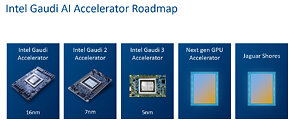- Joined
- Aug 19, 2017
- Messages
- 2,634 (0.98/day)
Intel's ambitious plan to challenge AMD and NVIDIA in the AI accelerator market may still be a little questionable, according to recent comments from interim co-CEO Michelle Johnston Holthaus at the Barclays 22nd Annual Global Technology Conference. The company's "Falcon Shores" project, which aims to merge Gaudi AI capabilities with Intel's data center GPU technology for HPC workloads, received surprising commentary from Holthaus. "We really need to think about how we go from Gaudi to our first generation of Falcon Shores, which is a GPU," she stated, before acknowledging potential limitations. "And I'll tell you right now, is it going to be wonderful? No, but it is a good first step."
Intel's pragmatic approach to AI hardware development was further highlighted when Holthaus addressed the company's product strategy. Rather than completely overhauling their development pipeline, she emphasized the value of iterative progress: "If you just stop everything and you go back to doing like all new product, products take a really long time to come to market. And so, you know, you're two years to three years out from having something." The co-CEO advocated for a more agile approach, stating, "I'd rather have something that I can do in smaller volume, learn, iterate, and get better so that we can get there." She acknowledged the enduring nature of AI market opportunities, particularly noting the current focus on training while highlighting the potential in other areas: "Obviously, AI is not going away. Obviously training is, you know, the focus today, but there's inference opportunities in other places where there will be different needs from a hardware perspective."


It seems like Falcon Shores won't be the savior that will get Intel at the level of NVIDIA in the GPU market, but rather a step toward a top-notch product. Intel's next iteration after Falcon Shore is called "Jaguar Shores", which will be the late 2025 or early 2025 product for data center AI and HPC. It seems like until Jaguar Shores arrives, a lot of effort goes into software and platform development to get it right. NVIDIA has dominated the game mainly due to its amazing CUDA software, despite competitors like AMD offering comparable hardware performance-wise. Intel needs to enable the software ecosystem a seamless integration of its next-gen accelerators first to ensure its Jaguar Shores GPU can catch up with the rest of the industry.
View at TechPowerUp Main Site | Source
Intel's pragmatic approach to AI hardware development was further highlighted when Holthaus addressed the company's product strategy. Rather than completely overhauling their development pipeline, she emphasized the value of iterative progress: "If you just stop everything and you go back to doing like all new product, products take a really long time to come to market. And so, you know, you're two years to three years out from having something." The co-CEO advocated for a more agile approach, stating, "I'd rather have something that I can do in smaller volume, learn, iterate, and get better so that we can get there." She acknowledged the enduring nature of AI market opportunities, particularly noting the current focus on training while highlighting the potential in other areas: "Obviously, AI is not going away. Obviously training is, you know, the focus today, but there's inference opportunities in other places where there will be different needs from a hardware perspective."


It seems like Falcon Shores won't be the savior that will get Intel at the level of NVIDIA in the GPU market, but rather a step toward a top-notch product. Intel's next iteration after Falcon Shore is called "Jaguar Shores", which will be the late 2025 or early 2025 product for data center AI and HPC. It seems like until Jaguar Shores arrives, a lot of effort goes into software and platform development to get it right. NVIDIA has dominated the game mainly due to its amazing CUDA software, despite competitors like AMD offering comparable hardware performance-wise. Intel needs to enable the software ecosystem a seamless integration of its next-gen accelerators first to ensure its Jaguar Shores GPU can catch up with the rest of the industry.
View at TechPowerUp Main Site | Source





